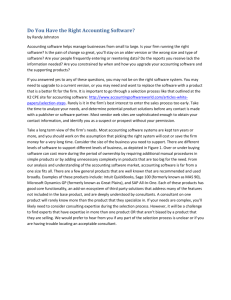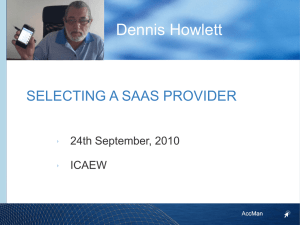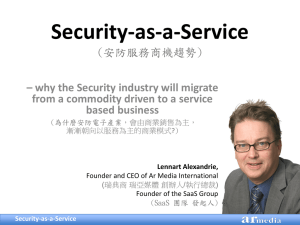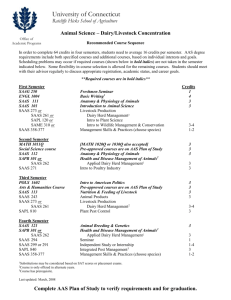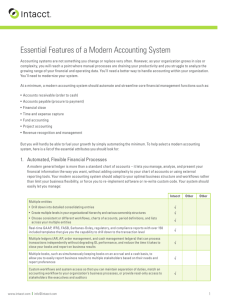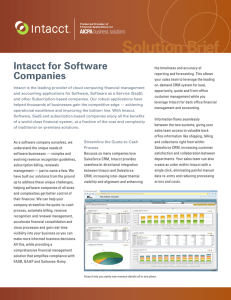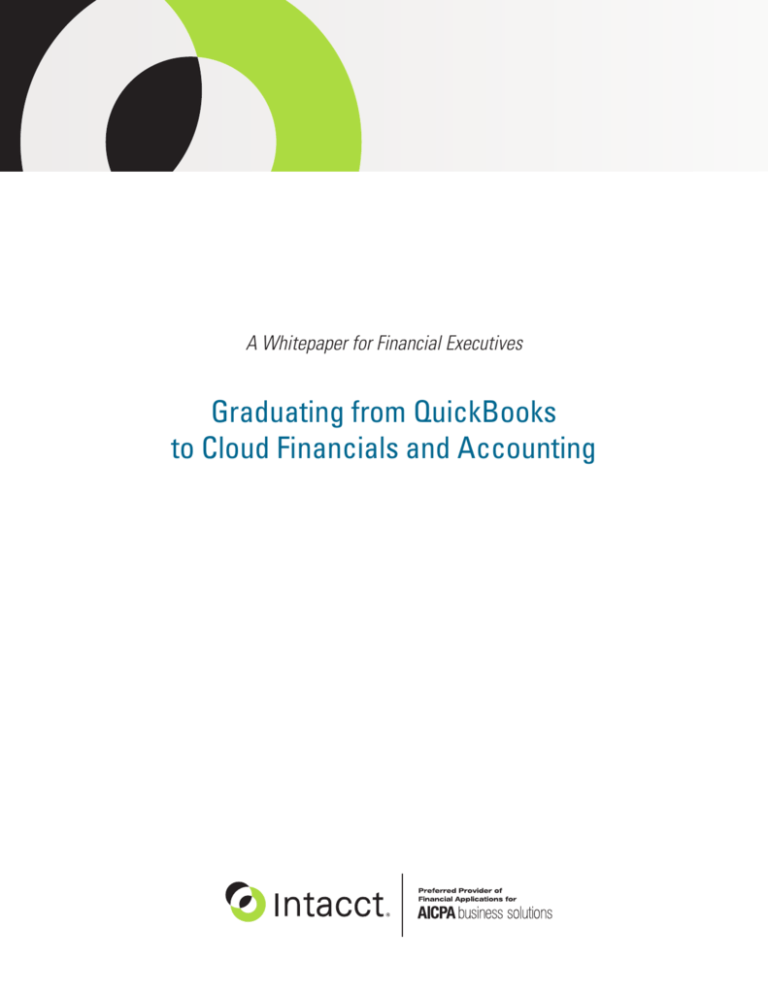
A Whitepaper for Financial Executives
Graduating from QuickBooks
to Cloud Financials and Accounting
Table of Contents
Executive Summary--------------------------------------------------------------------------- 3
Introduction------------------------------------------------------------------------------------ 4
Trends Reshaping Financial Management Needs----------------------------------------- 5
Evolving Business Requirements----------------------------------------------------------- 8
Making the Choice Between SaaS vs. On-Premise Solutions-------------------------- 9
Summary and Conclusions------------------------------------------------------------------ 10
About Intacct--------------------------------------------------------------------------------- 10
Intacct White Paper | Graduating from QuickBooks to Cloud Financials and Accounting
2
Executive Summary
A series of market trends are reshaping the financial management needs of companies of all sizes,
especially small and mid-size businesses.
As they grow, these companies are faced with the same business and legal requirements as
larger enterprises. At the same time, the growth of the Internet has created an increasingly
dispersed workforce that must submit key data to a company’s financial system and be able to
access this corporate information from anywhere, at anytime to do their jobs.
These requirements are driving some growing firms to investigate alternatives to packaged
software such as Intuit’s QuickBooks ® which many young companies rely upon in their initial
stages. These companies are often seeking an accounting system that:
•
Automates complex revenue management, including support for deferred revenue
management and multi-element arrangements
•
Supports multiple business entities and on-demand financial consolidation
•
Delivers real-time financial and operational visibility
•
Provides auditability that satisfies regulatory and compliance requirements
•
Seamlessly integrates with other applications in your ecosystem
•
Provides anytime, anywhere access
In the past, graduating from QuickBooks meant acquiring a costly and complex on-premise
software application. These applications entailed a significant upfront investment, long
deployment cycles, and cumbersome business processes.
Today, a new breed of cloud computing or Software-as-a-Service (SaaS) solutions has emerged
to address businesses’ real-time financial management needs. This report is based on findings
from THINKstrategies’ research which shows that these powerful and flexible SaaS solutions
are gaining widespread adoption across nearly every application category, including financial
management.
This whitepaper will discuss these trends and examine how cloud-based financial management
solutions are responding to the growing needs of small and mid-sized organizations.
Intacct White Paper | Graduating from QuickBooks to Cloud Financials and Accounting
3
Introduction
Today’s growing businesses are facing unprecedented challenges and opportunities.
On the positive side, they have the opportunity to capitalize on global markets and resources
by virtue of today’s telecommunications networks, electronic commerce outlets and lower
international trade restrictions. As a result, companies of all sizes are leveraging lower cost
materials and skills abroad, and selling to new markets worldwide. On the other hand, companies
must also contend with escalating competition and more complex operating requirements.
Differentiating a company’s products and services is becoming more difficult in an increasingly
commoditized marketplace. Therefore, gaining a competitive advantage and maintaining a loyal
customer base is also harder.
At the same time, many businesses are increasingly reliant on a dispersed workforce of remote or
mobile employees. They must also communicate more effectively with an expanding network of
global suppliers, channel partners and customers.
In order to manage these escalating challenges and fully capitalize upon today’s expanding
market opportunities, an increasing number of growing businesses are recognizing that they must
adopt more sophisticated financial management systems to properly support their businesses.
Some young companies have used Intuit’s QuickBooks to track their finances, but now need a
more robust financial management system to handle their increasingly complicated transactions.
They need to better forecast and track their revenue flows, keep a closer eye on their cost
structures and adhere to tighter accounting and regulatory compliance standards.
In the past, when companies graduated from QuickBooks, they would have to make significant
investments in costly and complex on-premise, financial management software to meet their
needs. These premise-based applications often required long deployment cycles, added hardware
to support the applications, and dedicated in-house information technology staff time to keep the
software up and running.
THINKstrategies’ research found that companies of all sizes are adopting a new generation of
cloud-based, Software-as-a-Service (SaaS) solutions to satisfy their business requirements. This
trend began with the adoption of customer relationship management, payroll and conferencing
solutions from SaaS vendors such as Salesforce.com, ADP and Webex/Cisco. The success of
these SaaS deployments has led to companies adopting comparable SaaS solutions to satisfy
their financial management software needs as well.
Intacct White Paper | Graduating from QuickBooks to Cloud Financials and Accounting
4
Trends Reshaping Financial Management Needs
Companies of all sizes are facing a combination of market trends which are forcing them to more
effectively manage their businesses. These trends include globalization, competition, worker
dispersion, and a growing acceptance of web-based, on-demand services.
Globalization has created new market opportunities, but has also opened the door to new market
competition. It has given companies access to new markets and cheaper offshore resources. It
has lowered the barriers to entry for a growing assortment of competitors who are increasingly
competing on price rather than product features.
Thomas Friedman in his book, The World is Flat, chronicled the globalization process and captured
the double-edged nature of this trend when he stated,
“One of the unintended consequences of the flat world is…individuals from every corner of the
flat world are being empowered. Globalization 3.0 makes it possible for so many more people
to plug and play.”
Global expansion has meant that companies must more effectively record global sales and
coordinate their global resources. They must also contend with multinational currency and tax
requirements. Companies must also accommodate increasingly dispersed workers who must
perform their job functions remotely or even on the run. They must also communicate with an
expanding array of suppliers and channel partners located worldwide. As a result, companies
must adopt new methods to give these remote workers and business partners easy access to
centralized and sensitive corporate data in a fast and secure fashion.
Small and mid-sized businesses are particularly affected by these new trends because they have
more limited financial resources to invest in traditional enterprise applications to manage their
business operations and they lack the in-house staff to administer this software. They are seeking
business applications which can meet their needs without the deployment and maintenance
complexities and costs which plagued traditional, on-premise applications. These on-premise
applications were often designed to comply with a company’s IT environment rather than respond
to its business needs, and have been inflexible and unable to provide the real-time access which
today’s workers need to perform their jobs.
The growing popularity of cloud-based services—such as Amazon, iTunes, and YouTube—in the
consumer market has set the standard for similar easy to use, economical, software solutions
to meet various corporate requirements. As consumers become comfortable using cloud-based
applications in their personal lives, they increasingly want to take advantage of comparable
solutions in their professional lives and work environments. These trends are fueling the rapid
growth of a new generation of web-based, Software-as-a-Service (SaaS) solutions.
Intacct White Paper | Graduating from QuickBooks to Cloud Financials and Accounting
5
Just as in the case of consumer-oriented cloud-based services, SaaS solutions aimed at business
users can be acquired on a subscription basis. This allows companies to acquire the functionality
they need incrementally without the risks historically associated with on-premise applications.
They also avoid the upfront deployment and ongoing support costs and hassles associated with
on-premise applications.
THINKstrategies’ survey research, in conjunction with Cutter Consortium, has found growing
interest and adoption of SaaS alternatives to traditional on-premise software. Although many
early adopters of SaaS deployed CRM and SFA solutions from companies such as Salesforce.com,
there is a rapidly expanding pool of solutions available. In fact, THINKstrategies’ Software-as-aService Showplace (www.saas-showplace.com), an online directory of SaaS solutions, includes
over 1600 offerings in over eighty (80) application and industry categories.
Research found that SaaS appeals to companies that have been unable to acquire the
sophisticated applications of the past, those who have grown tired of the complexities and costs
of premise-based applications, and others who have outgrown the capabilities of their existing
applications. [See Figure 1]
Figure 1
SaaS Appeals to New Software Users and Companies Migrating from Existing Applications
Many SaaS offerings have been specifically designed to scale to meet the needs of both small and
large enterprises.
THINKstrategies’ survey research has found that over 80% of users are satisfied with their SaaS
solutions, plan to expand their use of SaaS and would recommend SaaS to others. A growing
number of market research firms have also recognized this trend. Research from Saugatuck
Technology indicates that finance executives already see SaaS as a way to bridge many of
their effectiveness gaps, increasing significantly the ability of finance to deliver on its goals,
particularly those goals related to operational improvements, ROI and managing risk.
Consider how finance executives view SaaS financial solutions today- the yellow (SaaS
Effectiveness) bars reveal that finance executives hold SaaS solutions in much higher regard than
their traditional, on-premise financial solutions (See Figure 2– SaaS Fills in the Gaps).
Intacct White Paper | Graduating from QuickBooks to Cloud Financials and Accounting
6
Figure 2
SaaS Fills the Gap
As a result, Gartner expects over 25% of all software sales to be via an on-demand model by
2010 and to show consistent growth through 2013 when worldwide SaaS revenue will total $16
billion for the enterprise application markets. In contrast, Forrester Research is forecasting that
traditional enterprise applications will only grow 4% per year during the same period.
According to a survey conducted by Goldman Sachs, in Feb 2010, we are currently experiencing
an “unstoppable” shift to SaaS. In their Small and Mid Sized Business survey, 58% of respondents
always consider Software-as-a-Service (SaaS) when making an application purchase and 39%
prefer a SaaS solution. In addition, the weaker economy appears to be benefiting SaaS and Cloud
adoption with 40% of respondents indicating that they are more likely to use SaaS, given a lower
total cost of ownership.
Even more interesting, their February survey data showed a shift in applications used, with
accounting and billing moving up to third on the list of most-used SaaS applications (49% of
respondents are users). This underscores that even in the most mission-critical areas, SaaS
acceptance has reached an inflection point.
The macro downturn has likely accelerated SaaS and Cloud adoption, as customers are forced to
look for lower-cost solutions to mission critical business problems. A total of 40% of their survey
respondents indicated that they would be more likely to use SaaS solutions in a weaker economy,
due to perceived cost-saving benefits, while only 4% said they were less likely to use a SaaS
solution.
Intacct White Paper | Graduating from QuickBooks to Cloud Financials and Accounting
7
Evolving Business Requirements
While companies of all sizes must employ increasingly sophisticated financial management to
control their corporate operations, small and mid-sized companies are particularly challenged to
contend with these issues. Many of these companies are either young or too small to be able to
justify the cost and complexities of traditional mid-market on-premise applications. Many have
initially relied on Intuit’s QuickBooks to meet their revenue and expense tracking needs but their
business requirements have evolved. These companies need:
Automation of Complex Revenue Management: As products and services become more complex,
so do revenue management and billing requirements. Companies today also need to comply with
increasingly complex revenue recognition guidelines. Most traditional mid-market accounting
systems are not designed to handle this increased complexity and many organizations are
forced to use manual spreadsheets to manage their revenue recognition and billing processes.
By leveraging a financial management system that enables you to automate these processes,
companies benefit significantly in higher finance productivity, faster close processes, and
simplified compliance.
Multi-Entity Focus: As companies grow, they often need to track revenues, expenses and
profitability across multiple business units. Rather than create multiple instances of financial
information for each entity which must be consolidated manually into a Microsoft Excel
spreadsheet, many companies seek an integrated, financial view of a company’s end-to-end
operations.
TM
Real-Time Financial and Operational Visibility: Many companies are looking to gain better realtime visibility into their business and more effectively distribute a consistent set of information to
all stakeholders. Often, Excel or a costly 3rd party reporting solution seem to be the only options.
By leveraging a financial system that incorporates both a multi-dimensional General Ledger
and an embedded reporting and analytics engine, companies can more easily analyze real-time
consolidated and local financial and operating metrics across their business with the ability to
drill down in real time to supporting details.
Auditability: Increasing regulatory and compliance requirements, such as Sarbanes-Oxley and
tightening GAAP guidelines, are forcing many businesses to demonstrate greater ‘auditability’
and ‘traceability’. These requirements become increasingly important when companies consider
public offerings or mergers with publicly held companies. Companies need to be able to make
prior period adjustments and easily view the change history to appease financial auditors
concerned about today’s stricter regulations.
Software Integration Capabilities: Savvy companies have adopted customer relationship
management (CRM), salesforce automation (SFA), project management, and other powerful
applications to automate and closely track their customer interactions. Rather than having to
input or access important customer data into or from multiple business applications, these
companies are seeking to tie together the applications to give their end-users and executives a
‘holistic’ view of their customer relationships.
Intacct White Paper | Graduating from QuickBooks to Cloud Financials and Accounting
8
Anywhere/Anytime Access: Many companies seek to give their workers remote access to
their financial management systems. These companies may also want to share their financial
management reports with their suppliers or other business partners. This means real-time input
into their financial management system and access to centralized business data, in a controlled
manner that complies with common business processes and practices, and offers robust security
to protect sensitive financial data.
Making the Choice Between SaaS vs. On-Premise Solutions
Companies who are graduating from QuickBooks have many options, but they primarily fall
into two categories— selecting another on-premise software package or shifting to a SaaS
alternative.
On-premise solutions from vendors like Microsoft, Oracle and Sage require that customers
purchase a perpetual license, as well as the hardware to support the software upfront. In
addition to these significant capital investments, on-premise applications also place the burden of
deploying and managing the software on the user, potentially increasing IT resource needs.
The new breed of SaaS offerings from companies like Intacct, permit users to pay on a
subscription basis and relieves them of the added hardware costs, as well as the deployment and
management hassles. This allows users to focus on leveraging the software functionality rather
than worrying about the application availability. The SaaS model also makes it easier for growing
companies to add more user licenses as they need them rather than having to purchase them
upfront regardless of need. Unlike on-premise applications which might be hosted by a software
vendor, today’s SaaS solutions have been built to fully leverage the web and permit end-users to
utilize the online applications anytime from anywhere.
Working online may raise security concerns for some companies, but the fact is that major
SaaS vendors, such as Intacct, are certified with higher level security procedures than most
businesses. While many are challenged to keep pace with the escalating security threats facing
their companies, it would require a significant investment and would not be feasible for most
companies to achieve the same level of security for on-premise applications. SaaS vendors
offer the same high-level security to all of their customers so they can be confident that their
applications and data are secure. On-premise application vendors are not required to take the
same precautions.
While some on-premise application vendors now offer hosting options, these simply shift their
applications offsite but don’t deliver the added benefits of SaaS solutions. For instance, SaaS
vendors are continuously updating their applications in a fashion which does not disrupt their
customers’ day-to-day operations the way periodic on-premise application upgrades historically
have done.
Intacct White Paper | Graduating from QuickBooks to Cloud Financials and Accounting
9
Some of the on-premise application vendors are promising to move to a SaaS platform but face
significant challenges making this transition. Moving from on-premise to a SaaS model requires
that they re-architect their applications, restructure their licensing models and reorient their
corporate cultures from being technology-centric to being services-oriented. It is for these
reasons that ‘net-native’ SaaS vendors have a big lead in the market over the legacy premisebased application.
Summary and Conclusions
Globalization, mobility and other mega-trends are rapidly changing the competitive landscape and
how businesses of all sizes must operate to succeed. Even relatively modestly sized companies
are facing challenges in managing their business operations, in terms of data entry and reporting,
auditing capabilities for tracking revenues and managing costs across multiple geographies, and
managing various product pricing schedules to serve differing target markets.
These needs are driving a growing number of companies to cloud based computing solutions,
such as Intacct’s financial management and accounting system which can be deployed quickly
and offers a wealth of functionality in an easy-to-use solution.
About Intacct
Intacct is the market and technology leader in web-based financial management and accounting
applications for businesses and CPA firms. Bringing cloud computing to finance and accounting,
Intacct’s award-winning applications are the preferred financial applications for AICPA
business solutions. Intacct applications are used by thousands of businesses from startups to
public companies and are designed to improve company performance and make finance more
productive. The Intacct system includes accounting, contract management, revenue recognition,
inventory, purchasing, vendor management, financial consolidation and financial reporting
applications, all delivered over the Internet via Software as a Service (SaaS).
Intacct is headquartered in San Jose, California. For more information, please visit
www.intacct.com or call 866-204-0287.
Intacct White Paper | Graduating from QuickBooks to Cloud Financials and Accounting
10
125 S. Market Street, Suite 600
San Jose, CA 95113
Phone: 1-877-437-7765
Email: info@intacct.com
www.intacct.com
The Intacct logo is a trademark of Intacct Corporation in
the United States. All other trademarks mentioned in this
document are the property of their respective owners.
© 2010 Intacct Corporation. All rights reserved.

